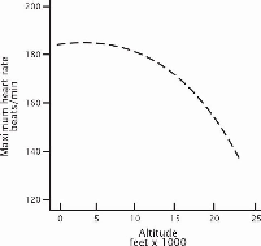Travel Reference
In-Depth Information
◆
An increase in the concentration of intracellular oxidative enzymes
◆
An increase in the size and number of mitochondria, the tiny structures that contain
oxidative enzymes within cells
Figure 24-3. Oxygen-hemoglobin dissociation curves: normal and the effects of carbon dioxide, pH,
and temperature
Thanks to these changes several million people throughout the world are able to live at
high altitudes.
Some populations that have lived at high altitude for many generations (for example,
in the high Andes, Caucasus, or Ethiopia) develop physical changes characteristic of their
specific genetic heritage. These generational changes are better called adaptation than ac-
climatization, and they convey a few special abilities, such as prolonged endurance at alti-
tude, and some superiority in endurance sports, such as marathon running at sea level.
Other Considerations
Acclimatization is an ongoing process that takes place over many weeks. The time re-
quired for different processes varies greatly and also varies between individuals. The res-
piratory and biochemical changes level off in a few weeks, but more time is needed for the
number of red blood cells to reach a maximum; at that time, secretion of erythropoietin de-
creases, but the bone marrow continues to produce the same number of red cells.
Above 20,000 feet (6100 m) deterioration outstrips acclimatization, and after ten to fif-
teen days at such altitudes climbers cannot continue without great risk.
Achieving Acclimatization
Individuals vary so widely in their ability to acclimatize, not only in the degree of ac-
climatization they can achieve but also in the time required, that no program fits everyone.
Generally speaking, the slower the climb, the better the acclimatization.

Search WWH ::

Custom Search